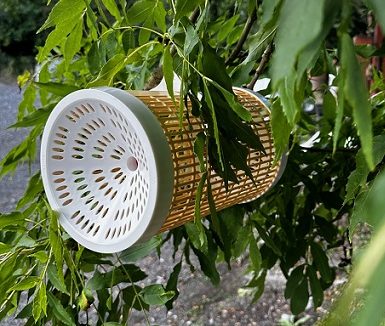Southern Europe is under attack!
Yes, European bees are indeed facing a significant threat from Asian hornets (Vespa velutina). These hornets, originally from Southeast Asia, have been spreading across Europe and pose a serious threat to local bee populations, particularly honeybees.
Remarkably, it has been discovered that bees send out a rallying call for collective defense against attacks from Asian Hornets according to a 2021 study published in the Royal Society Open Science journal. Named ‘the anti-predator pipe’ the signal was previously undiscovered. The study details how the ‘pipe’ shares acoustic traits with “alarm shrieks, fear screams and panic calls of primates, birds and meerkats”.

A defensive ball of Japanese honey bees (A. c. japonica) in which two Japanese hornets (V. simillima xanthoptera) are engulfed, incapacitated, heated, and eventually killed. This sort of defense is also used against the Asian giant hornet.

How Asian Hornets Affect European Bees
- Predation: Asian hornets are efficient predators of bees. They tend to hover outside beehives, catching worker bees as they return to the hive. A single hornet can kill multiple bees per minute, significantly depleting a hive’s population.
- Hive Invasion: In some cases, Asian hornets can enter beehives to feed on bee larvae and pupae. This not only reduces the number of future bees but also causes stress and panic within the hive.
- Impact on Pollination: The reduction in bee populations due to hornet predation can have broader ecological consequences, as bees are crucial pollinators for many plants, including crops. This can affect biodiversity and agricultural productivity.
Spread and Control Efforts
Asian hornets were first reported in France in 2004, likely introduced accidentally via shipping containers. Since then, they have spread to several other European countries, including Spain, Portugal, Italy, and the United Kingdom.
Control measures are challenging but essential. Efforts include:
- Monitoring and Reporting: Observing and documenting sightings of Asian hornets can help track their spread and target control efforts.
- Trapping: Special traps can capture hornets, reducing their numbers. However, these traps need to be carefully managed to avoid harming other insect species.
- Destroying Nests: Locating and destroying hornet nests is crucial, especially before they produce new queens, which can start new colonies.
Apitech World recently investigated a new solution to the Asian Hornet problem…. The Gard Apis trap.
This Asian Hornet trap is designed to be highly selective and only trap Asian Hornets. It is also designed to do no harm to other insects. It is easy to use, affordable and quick to redeploy. Feedback in the bee community has been incredibly positive and this solution amongst others leads Apitech World to remain positive despite the challenges facing bee lovers across the continent.
Importance of Awareness
Public awareness and cooperation are vital in controlling the spread of Asian hornets. People are encouraged to report sightings to local authorities or specialized apps designed for monitoring invasive species. The fight against this invasive species is ongoing, and coordinated efforts are essential to protect local ecosystems and agriculture.
Technology is the solution.

